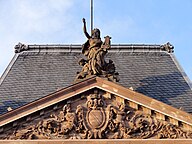Roof
**1. Roof Design and Structure:**
– Roof materials range from banana leaves to wood shakes and shingles.
– Roof construction is determined by support method and pitch.
– Different types of roofing require specific pitches for waterproofing.
– Roof shapes vary based on climate and available materials.
– Basic roof shapes include flat, gabled, hipped, arched, and domed.
– Roof structure typically supported by beams made of timber, cast iron, or steel.
– Stone lintels and arches historically used for roof support.
– Steel girders and reinforced concrete beams provide structural support.
**2. Roof Functions and Insulation:**
– Roof sheds water to prevent standing water and increase live load.
– Protects building interior from weather elements like rain, wind, sun, heat, and snow.
– Provides thermal insulation with minimum R-value requirements.
– Desired appearance for aesthetics and curb appeal.
– Roofing materials like thatch have natural insulation properties.
– Ceilings are installed for insulation against heat, cold, noise, and dirt.
– Various insulation forms like felt, plastic, foam, and recycled materials are used.
**3. Roofing Materials:**
– Slate roofs are durable and can last 75 to 150 years.
– Asbestos was widely used in the 20th century but is now banned.
– Green roofs made of turf have good insulating properties.
– Clay roofs like adobe are common in low rainfall areas.
– Metal roofing options like copper, lead, and steel are durable choices.
**4. Roof Drainage and Maintenance:**
– Roofs must repel water and direct it away to prevent damage.
– Proper drainage prevents water damage and inconvenience.
– Ice dams can form from poorly insulated roofs, causing structural damage.
– Cool roofs with high reflectivity and thermal emittance are becoming popular.
– Regular maintenance ensures roofs perform for expected service life.
**5. Solar Roofs and Innovative Roof Designs:**
– Solar shingles can generate electricity and cover the roof.
– Solar systems can generate hot water or hot air.
– Solar systems can be integrated by covering pitched roofs with solar shingles.
– Solar panels can be mounted on existing roofs or flat roof membranes.
– Various innovative roof designs showcased in different regions and historical landmarks.
This article needs additional citations for verification. (June 2012) |
A roof (pl.: roofs or rooves) is the top covering of a building, including all materials and constructions necessary to support it on the walls of the building or on uprights, providing protection against rain, snow, sunlight, extremes of temperature, and wind. A roof is part of the building envelope.
The characteristics of a roof are dependent upon the purpose of the building that it covers, the available roofing materials and the local traditions of construction and wider concepts of architectural design and practice, and may also be governed by local or national legislation. In most countries, a roof protects primarily against rain. A verandah may be roofed with material that protects against sunlight but admits the other elements. The roof of a garden conservatory protects plants from cold, wind, and rain, but admits light.
A roof may also provide additional living space, for example, a roof garden.






